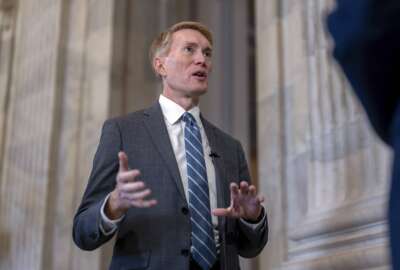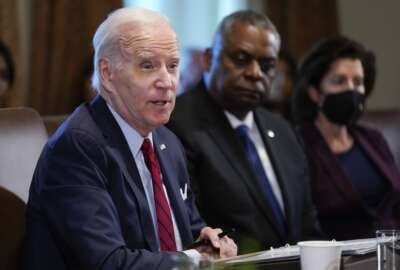Longer leases, improved space utilization key to big savings for GSA
With half of all federal leases in the D.C. region expiring in the next five years and a "buyers market" in real estate, the federal government faces a huge...
More than half of the General Services Administration’s leases in the Washington, D.C., area will be expiring in the next five years, which presents a cost-savings opportunity for the federal government.
The House Subcommittee on Economic Development, Public Buildings and Emergency Management hosted a round table discussion Wednesday on how GSA and agencies can take advantage of what subcommittee Chairman Lou Barletta (R-Pa.) called a “buyer’s market.
GSA currently leases 56 million square feet of office space in the national capital region, with 500 leases representing 32 million square feet of office space set to expire by 2020.
The round table included representatives from private industry, GSA and the departments of Health and Human Services, Homeland Security and Justice. The latter three agencies account for 44 percent of the building leases due to expire over the next five years.
The round table focused on two ways GSA could take advantage of such a significant number of leases expiring in such a short time — improving space utilization rates and signing long-term leases.
Designing for the 21st century workplace
James Michael Reidy, senior managing director of Savills Studley, spoke about the importance of developing workplace strategies to reduce the footprint end cost to agencies and focus on the way 21st century offices function.
“We’re working more collaboratively,” Reidy said. “We have a lot more mobility in the way we go to work and have to recognize the reality between cost and budget that we have to work with today, both on the commercial and the federal.”
Reidy referenced a 2012 GSA report on workplace utilization that stated current workspace is occupied between 35 percent and 50 percent during the traditional 8 a.m. and 5 p.m. workday.
“The causes are collaboration,” he said. “It’s what you want to call telework either from home or on the road and being out in the field, because we’re more mobile. We carry smartphones, tablets, laptops — we work from wherever we need to. The result is underutilized space, which is a legal obligation that the agencies have to pay first and foremost. So, for the space that they’re not using, that’s money that could be applied back to mission, to staff, to equipment, to training.”
Reidy recommended the federal government take a “combined arms approach” of real estate, human capital change management and mobile workplace technology to leverage the most out of the office space it already uses.
“We’re dealing with change to culture,” he said. “We’re dealing with going from ‘I’m aiming for that corner office’ to ‘I need to be where I can do some work. I’m working more collaboratively.’ The millennial workforce has had a tremendous impact on all of us. We are now working more in groups. We’re not sitting at that desk, but we do come in and we’re using it. So, we need to figure out the right mix.”
Freezing the Footprint
Agencies have already been focusing on consolidating their office space. Former Office of Management Budget Director Danny Werfel issued his 2013 Freezing the Footprint memo, which directed agencies to “develop plans that will serve as the basis for agency actions to restrict the growth in their office and warehouse inventories.”
“I’m not saying, ‘Let’s get draconian and let’s figure out how to squeeze more people into the right space,'” Reidy said. “Let’s figure out how we’re currently going to work so we can right-size our requirements. And this is a perfect storm because we have all these leases expiring. And on the real estate side, if we start to line up the dominoes correctly, we can start to ‘ping’ the leases as they start to come off their run.”
Reidy described a situation where an agency could consolidate its staff into a temporary space and then renovate the new open space for the staff to eventually move into, thereby eliminating costly “swing space” during the renovation. The renovation will create a new “right-sized” space that fits the staff’s needs. Once the staff moves into the renovated space, that frees up the original space for disposal or reuse by another component or agency.
“We can take another organization, with another location within the same cityscape and move them into that last piece and let that last lease expire,” Reidy said. “That’s what I mean by setting up the dominoes. It’s great for the agencies, they can turn back space to GSA. … So, working together and getting this lined up is where you really need to start to move this. Then everybody wins and we can put more money towards mission.”
Finding savings in long-term leases
As leases in the the capital region come up for renewal, GSA can also save money by negotiating longer term leases.
“From a market timing perspective, there has never been a better time to be a consumer of real estate in the national capital region,” said Scott Homa, Mid- Atlantic research director of Jones Lang LaSalle, a professional services and investment management company.
He told the round table that vacancy rates were at an all-time high of 17 percent, and it’s the first time his company has seen vacancy rates higher in the D.C. area above the national average. This has led to lower rental rates in the region.
“From the perspective of cost, competition and choice, there’s tremendous leverage right now for the federal government,” Homa said, adding that the federal government was “leaving money on the table” by not locking in these lower rates for a longer period of time.
“When a short-term lease is being signed, not only do you capture what can be above-market concession packages, in terms of free rent and build out allowances, but you’re also having a debilitating impact on the value of the building, the ability of the owner to refinance it or sell it,” he said. “Therefore, there is aligned interests within the private sector and tenants in a down market to lock- in long-term deals. For that reason, I think that there is tremendous opportunity in the marketplace.”
Darren Blue, regional commissioner for GSA’s Public Building Service, told the round table that 300-plus leases will be expiring in the Washington, D.C., area over next three fiscal years.
“I’m happy to announce as you look at 2017, we’re looking at 50 percent of those leases already have a plan in place,” he said. “A plan in place means that we’re engaged with that tenant agency, we’re capturing requirements and we’re applying all of the principles that were discussed earlier, as well as the reduction of the footprint goals that have been mandated.”
In the nearer term, Blue said, 85 percent of PBS’ leases have plans in place for lease replacement or an extension linked, if appropriate, to a longer-term strategy, such as consolidation into federal office space or as part of an ongoing capital project.
RELATED STORIES:
Agencies forced to freeze office space footprint
Public Buildings commissioner wants to help agencies consolidate, modernize workspace
GSA declares end to cube farms, unveils new approach to office space
Copyright © 2024 Federal News Network. All rights reserved. This website is not intended for users located within the European Economic Area.
Michael O’Connell is senior digital editor of Federal News Network optimizing content for the best user experience. Follow @moconnellWFED
Follow @moconnellWFED






